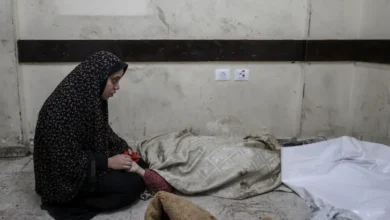‘Until my last breath’: Searching for relatives at Syria’s ‘slaughterhouse’

For decades, Sednaya prison was only ever mentioned in hushed tones in Syria. Torture and death were known to be routine in this place everyone called the “human slaughterhouse”.
But on the evening of December 7, that all ended when Syrian opposition fighters burst through doors and liberated the prisoners.
In no time, thousands of Syrians descended on the prison in the mountains north of Damascus, desperately seeking news of the loved ones they believed had disappeared behind the prison’s walls.
Standing in front of the prison, Jumaa Jubbu, who is from al-Kafir in Idlib, said: “The liberation [of Syria] is an indescribable joy.
“But the joy is incomplete because there are [hundreds of thousands] of missing detainees, and we haven’t heard any news about them at all.”
False hope
Sednaya’s two buildings may have been holding as many as 20,000 prisoners, according to Amnesty International.
At one point, a loud bang rang out from a far wall of the prison and shouts spread through the crowd.
Someone had broken through and there were hopes they had found an entry to the rumoured cells. People began running towards the sound, shouting “God is the greatest”.
But, seconds later, the shouts died down and people turned away – a false hope. There was no entrance.
“We’re waiting, hoping that God will guide us to find the underground prison, because most of the prisoners who were released before, they say the prison has three underground levels,” Jubbu said. “We only saw one floor.”
Jubbu said he was searching for 20 people from his village, among them his cousins. All had been taken in the early years of the war, between 2011 and 2013 and were believed to have ended up at the “slaughterhouse”.
But just a few hours later, a statement was released by the Association of Detainees and Missing in Sednaya Prison which said the last liberated prisoner had been released at 11am the day before.
‘The smells are indescribable’
Syrian opposition fighters liberated Aleppo, Hama, and Homs on their way to Damascus. In each city, they opened up the prison doors and liberated tens of thousands of people.
But more remain missing.
On the road to Sednaya, people drove as far as they could before the crush of people forced them to park and continue on foot.
Young and old, men and women, some holding children – all climbed up the unpaved incline to the infamous prison.
Under the now-defeated regime, Sednaya was a military prison where many were held on charges of “terrorism” which, in reality, meant had been arrested for any number of arbitrary reasons.
Many of the people Al Jazeera spoke to there said their relatives had done nothing wrong.
Some weren’t even sure their loved ones were here, they had come because they’d heard from someone that their relative “might” be here. Or they had checked other prisons and still hadn’t found any trace.










